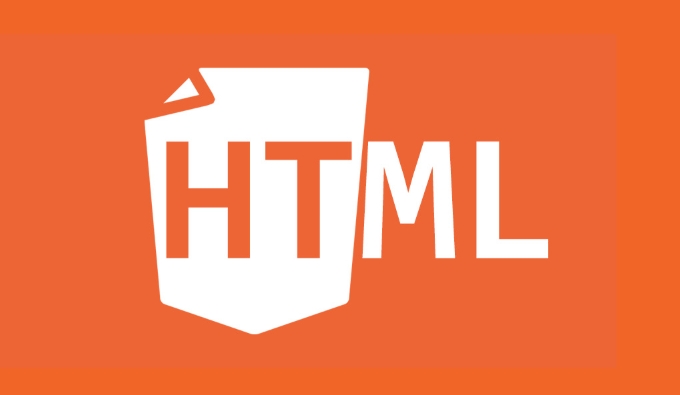Creating Dropdown Lists with the HTML select and option Elements
Jul 05, 2025 am 01:40 AMTo implement drop-down lists in web pages, a common method is to use the combination of <select> and <option> tags in HTML. 1. Basic structure: Use <select> to create an optional menu; 2. Set default selections: add selected attributes on a certain <option>; 3. Group display options: Use <optgroup> to organize options by category; 4. Multiple selection function: Add multiple attributes to <select> to support multiple selection. In addition, the form function can be enhanced by combining required and name attributes.

In web development, drop-down lists are a common and practical interactive element. To achieve it, the most common way is to use the <select></select> and <option></option> tag combination in HTML. They allow you to easily create a menu where users can select a value from multiple options.

Basic structure: How to write a simple drop-down menu
Creating a drop-down list is actually very simple. Just one <select></select> tag is needed to wrap multiple <option></option> tags, each <option></option> represents an optional option. for example:

<select> <option value="apple">Apple</option> <option value="banana">Banana</option> <option value="orange">orange</option> </select>
This creates a drop-down box that can be clicked to expand and select fruit. By default, the browser displays the first option as the initial selection.
If you want the user to select an option to submit the form, you can add the required attribute:

-
<select required>
You can also set name attribute to let this drop-down menu bring the corresponding name when submitting the form:
-
<select name="fruit">
Set default selection: Make an option automatically selected
Sometimes you want the page to load and there is an option that is selected by default. At this time, you can use selected attribute on <option> . For example:
<option value="banana" selected>Banana</option>
Once the page opens, "Banana" will appear in the drop-down box. It should be noted that selected is a Boolean property that does not require assignment, and it will take effect as long as it is written.
If you have multiple <option> s added selected , the browser will usually only select the first one that appears. So it is recommended to add this attribute to only one option.
Group display options: Use optgroup to classify options
When there are many options and there are obvious classifications, you can use the <optgroup> tag to display the relevant <option> in groups. for example:
<select>
<optgroup label="domestic mobile phone">
<option value="huawei">Huawei</option>
<option value="xiaomi">Xiaomi</option>
</optgroup>
<optgroup label="International Brand">
<option value="apple">Apple</option>
<option value="samsung">Samsung</option>
</optgroup>
</select> This will make the drop-down menu look more organized. Note that <optgroup> cannot be selected by itself, but is only used to organize content. And nesting is not currently supported, which means that you cannot put another <optgroup> in a <optgroup> .
Multiple values ??are available: let the user select multiple options at once
If you want the user to have multiple choices, you can add multiple attribute to the <select> tag:
<select multiple> <option value="red">Red</option> <option value="green">Green</option> <option value="blue">blue</option> </select>
At this time, the user can select multiple options by holding down Ctrl (or Command on Mac). Some browsers also display as a list of scrolling up and down instead of a drop-down box that is folded up.
If you want to limit the maximum number of selected two, you need to cooperate with JavaScript to control the number of selected items, because HTML itself does not provide the function of limiting the number of selected items.
Basically that's it. Using <select></select> and <option></option> to build a drop-down menu is not complicated, but you can flexibly adjust the style and behavior according to your needs.
The above is the detailed content of Creating Dropdown Lists with the HTML select and option Elements. For more information, please follow other related articles on the PHP Chinese website!

Hot AI Tools

Undress AI Tool
Undress images for free

Undresser.AI Undress
AI-powered app for creating realistic nude photos

AI Clothes Remover
Online AI tool for removing clothes from photos.

Clothoff.io
AI clothes remover

Video Face Swap
Swap faces in any video effortlessly with our completely free AI face swap tool!

Hot Article

Hot Tools

Notepad++7.3.1
Easy-to-use and free code editor

SublimeText3 Chinese version
Chinese version, very easy to use

Zend Studio 13.0.1
Powerful PHP integrated development environment

Dreamweaver CS6
Visual web development tools

SublimeText3 Mac version
God-level code editing software (SublimeText3)

Hot Topics
 How do I stay up-to-date with the latest HTML standards and best practices?
Jun 20, 2025 am 08:33 AM
How do I stay up-to-date with the latest HTML standards and best practices?
Jun 20, 2025 am 08:33 AM
The key to keep up with HTML standards and best practices is to do it intentionally rather than follow it blindly. First, follow the summary or update logs of official sources such as WHATWG and W3C, understand new tags (such as) and attributes, and use them as references to solve difficult problems; second, subscribe to trusted web development newsletters and blogs, spend 10-15 minutes a week to browse updates, focus on actual use cases rather than just collecting articles; second, use developer tools and linters such as HTMLHint to optimize the code structure through instant feedback; finally, interact with the developer community, share experiences and learn other people's practical skills, so as to continuously improve HTML skills.
 How do I embed PHP code in an HTML file?
Jun 22, 2025 am 01:00 AM
How do I embed PHP code in an HTML file?
Jun 22, 2025 am 01:00 AM
You can embed PHP code into HTML files, but make sure that the file has an extension of .php so that the server can parse it correctly. Use standard tags to wrap PHP code, insert dynamic content anywhere in HTML. In addition, you can switch PHP and HTML multiple times in the same file to realize dynamic functions such as conditional rendering. Be sure to pay attention to the server configuration and syntax correctness to avoid problems caused by short labels, quotation mark errors or omitted end labels.
 How do I embed video in HTML using the element?
Jun 20, 2025 am 10:09 AM
How do I embed video in HTML using the element?
Jun 20, 2025 am 10:09 AM
To embed videos in HTML, use tags and specify the video source and attributes. 1. Use src attributes or elements to define the video path and format; 2. Add basic attributes such as controls, width, height; 3. To be compatible with different browsers, you can list MP4, WebM, Ogg and other formats; 4. Use controls, autoplay, muted, loop, preload and other attributes to control the playback behavior; 5. Use CSS to realize responsive layout to ensure that it is adapted to different screens. Correct combination of structure and attributes can ensure good display and functional support of the video.
 How do I minimize the size of HTML files?
Jun 24, 2025 am 12:53 AM
How do I minimize the size of HTML files?
Jun 24, 2025 am 12:53 AM
To reduce the size of HTML files, you need to clean up redundant code, compress content, and optimize structure. 1. Delete unused tags, comments and extra blanks to reduce volume; 2. Move inline CSS and JavaScript to external files and merge multiple scripts or style blocks; 3. Simplify label syntax without affecting parsing, such as omitting optional closed tags or using short attributes; 4. After cleaning, enable server-side compression technologies such as Gzip or Brotli to further reduce the transmission volume. These steps can significantly improve page loading performance without sacrificing functionality.
 How has HTML evolved over time, and what are the key milestones in its history?
Jun 24, 2025 am 12:54 AM
How has HTML evolved over time, and what are the key milestones in its history?
Jun 24, 2025 am 12:54 AM
HTMLhasevolvedsignificantlysinceitscreationtomeetthegrowingdemandsofwebdevelopersandusers.Initiallyasimplemarkuplanguageforsharingdocuments,ithasundergonemajorupdates,includingHTML2.0,whichintroducedforms;HTML3.x,whichaddedvisualenhancementsandlayout
 How do I use the element to represent the footer of a document or section?
Jun 25, 2025 am 12:57 AM
How do I use the element to represent the footer of a document or section?
Jun 25, 2025 am 12:57 AM
It is a semantic tag used in HTML5 to define the bottom of the page or content block, usually including copyright information, contact information or navigation links; it can be placed at the bottom of the page or nested in, etc. tags as the end of the block; when using it, you should pay attention to avoid repeated abuse and irrelevant content.
 What is the declaration, and what does it do?
Jun 24, 2025 am 12:57 AM
What is the declaration, and what does it do?
Jun 24, 2025 am 12:57 AM
Adeclarationisaformalstatementthatsomethingistrue,official,orrequired,usedtoclearlydefineorannounceanintent,fact,orrule.Itplaysakeyroleinprogrammingbydefiningvariablesandfunctions,inlegalcontextsbyreportingfactsunderoath,andindailylifebymakingintenti
 How do I use the tabindex attribute to control the tab order of elements?
Jun 24, 2025 am 12:56 AM
How do I use the tabindex attribute to control the tab order of elements?
Jun 24, 2025 am 12:56 AM
ThetabindexattributecontrolshowelementsreceivefocusviatheTabkey,withthreemainvalues:tabindex="0"addsanelementtothenaturaltaborder,tabindex="-1"allowsprogrammaticfocusonly,andtabindex="n"(positivenumber)setsacustomtabbing






